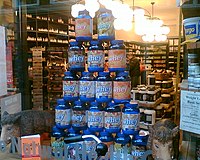Whey protein
From Wikipedia, the free encyclopedia

| This article includes a list of references or external links, but its sources remain unclear because it lacks inline citations. Please improve this article by introducing more precise citations where appropriate. (April 2009) |
Whey protein is the collection of globular proteins that can be isolated from whey, a by-product of cheese manufactured from cow's milk. It is typically a mixture of beta-lactoglobulin (~65%), alpha-lactalbumin (~25%), and serum albumin (~8%), which are soluble in their native forms, independent of pH. Whey has the highest biological value (BV) of any known protein.
The protein fraction in whey (approximately 10% of the total dry solids within whey) comprises four major protein fractions and six minor protein fractions. The major protein fractions in whey are beta-lactoglobulin, alpha-lactalbumin, bovine serum albumin and immunoglobulins. Each of these components has important disease-fighting effects.[citation needed] In addition, whey protein is easily digestible.
Contents |
[edit] Denaturation by heat
Whey protein can be denatured by heat. High heat (like the sustained high temperatures above 72 degrees Celsius (160 degrees Fahrenheit) associated with the pasteurization process) denatures whey proteins, destroying some bioactive compounds, such as the amino acid cystine. While native whey protein does not aggregate upon renneting or acidification of milk, denaturing the whey protein triggers hydrophobic interactions with other proteins, and the formation of disulfide bonds between whey proteins and casein micelles, leading to aggregation with other milk proteins at low pH.
[edit] Major forms
Whey protein typically comes in three major forms: concentrate, isolate, and hydrolysate.
- Concentrates contain a low level of fat and cholesterol but, in general, have higher levels of bioactive compounds, and carbohydrates in the form of lactose — they are 29%-89% protein by weight.
- Isolates are processed to remove the fat, and lactose, but are usually lower in bioactive compounds as well — they are 90%+ protein by weight. Both of these types are mild to slightly milky in taste.
- Hydrolysates are predigested, partially hydrolyzed whey proteins that, as a consequence, are more easily absorbed, but their cost is generally higher. Whey protein hydrolysate also tends to taste quite different than other forms of whey protein, usually in a way that many find undesirable but can be masked when used in beverages.[citation needed]
[edit] Uses

More than other protein supplements, whey protein powder is commonly used by bodybuilders and other athletes to accelerate muscle development and aid in recovery. Some individuals with suppressed or otherwise abnormal immune systems or degenerative diseases use undenatured bioactive whey proteins to increase their antioxidant levels. These native whey proteins are a good source of cysteine, a conditionally essential amino acid, which is the rate-limiting factor for the body's production of glutathione[1], an important antioxidant.
Whey protein has also seen increased use among people trying to maintain or lose weight. Whey protein is a high quality, low fat protein and is used successfully in many diet programs. Recent studies have shown that high protein meals decrease ghrelin concentrations in the body and therefore satiate hunger. [2]
In a study, it was found that whey supplements may prevent blood sugar spikes after high-carbohydrate meals, which is useful for diabetics.[3]
[edit] See also
[edit] References
- ^ [1]Noda, T. et al. Exogenous cysteine and cystine promote cell proliferation in CaCo-2 cells. Cell Proliferation, Volume 35, Number 2, April 2002 , pp. 117-129(13)
- ^ Effect of a high-protein breakfast on the postprandial ghrelin response AJCN
- ^ Whey May Curb Effect of Carbs on Blood Sugar by Jennifer Warner Reviewed by Michael W. Smith, MD Web MD
- Health and Whey Proteins at PDRHealth.com Article
- Eason RR, Till SR, et al. Tumor-protective and tumor-promoting actions of dietary whey proteins in an N-methyl-N-nitrosourea model of rat mammary carcinogenesis. Nutr Cancer 2006;55(2):171-7 PubMed
- Barth CA, Behnke U. [Nutritional physiology of whey and whey components.] [Article in German.] Nahrung. 1997; 41:2-12.
- Bell S J. Whey protein concentrates with and without immunoglobulins: a review. J med Food. 2000; 3:1-13.
- Bounous G, Batist G, Gold P. Immunoenhancing property of a dietary whey protein in mice: role of glutathione. Clin Invest Med. 1989; 12:154-161. PubMed
- Bounous G, Batist G, Gold P. Whey proteins in cancer prevention. Cancer Lett. 1991; 57:91-94. PubMed
- Bounous G, Gervais F, Amer V, et al. The influence of dietary whey protein on tissue glutathione and the diseases of aging. Clin Invest Med. 1989; 12:343-349. PubMed
- Kennedy RS, Konok GP, Bounous G, et al. The use of a whey protein concentrate in the treatment of patients with metastatic carcinoma: a phase I-II clinical study. Anticancer Res. 1995; 15(6B):2643-2649. PubMed
- Kinsella JE, Whitehead DM. Proteins in whey: chemical, physical, and functional properties. Adv Food Nutr Res. 1989; 33:343-438. PubMed
- Papenburg R, Bounous G, Fleiszner D, Gold P. Dietary milk proteins inhibit the development of dimethylhydrazine-induced malignancy. Tumor Biol. 1990; 11:129-136. PubMed
- Tong LM, Sasaki S, McClements DJ, Decker EA. Mechanisms of the antioxidant activity of a high molecular weight fraction of whey. J Agric Food Chem. 2000; 48:1473-1478. PubMed
- Vandenplas Y, Hauser B, Van den Borre C, et al. Effect of a whey hydrolysate prophylaxis of atopic disease. Ann Allergy. 1992; 68:419-424. PubMed
- Wong CW, Watson DL. Immunomodulatory effects of dietary whey proteins in mice. J Dairy Res. 1995; PubMed

